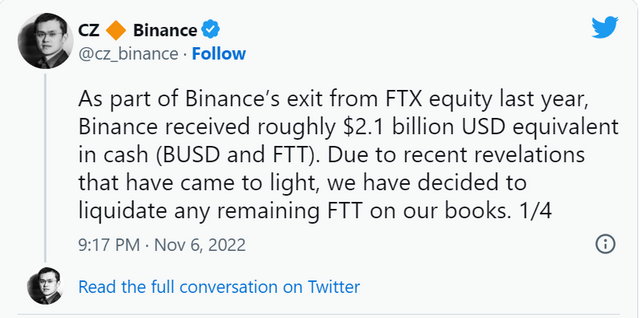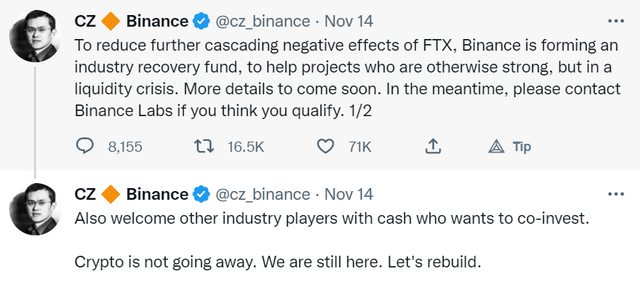How FTX went bankrupt by CZ's one tweet
Soon after founding the now-defunct FTX, a cryptocurrency exchange, Sam Bankman-Fried and his co-founders decided to create their own virtual currency a la bitcoin.
"There's no reason not to generate tokens if you're in crypto," says Hilary Allen, American University Washington College of Law professor. "You have the ability to generate tokens out of thin air." The FTX Token, or FTT as it is more often known, launched in 2019, and the digital currency reached a peak of about $80 a few years later. There are around 250 million FTX Tokens in circulation now. Not bad for something as simple as data.
Although it was a significant revenue generator for FTX and helped keep Bankman-Fried's hedge fund afloat, the FTX Token ultimately proved to be the company's undoing. After a report in CoinDesk earlier this month raised concerns about FTX’s financials, Binance CEO Changpeng Zhao chose to sell his company’s significant FTT holdings. This alarmed investors, and the token’s value plummeted as word spread.
The tokens, like airline miles, benefited customers but accomplished nothing else outside of the corporation. To entice customers, the FTX Token was part of a complex, rewards-based marketing plan. “I think of it like airline miles,” says Ariel Zetlin-Jones, an economics professor at Carnegie Mellon. “Like a reward for utilizing the exchange.” Customers that purchased FTT were able to trade on the company’s exchange at a discounted rate. The tokens might also be used as collateral. Token holders were treated as VIPs by the firm.
Bankman-firm Fried’s refers to FTT as “the backbone of the FTX ecosystem” on their website. Customers, however, were unaware that the tens of millions of tokens were not broadly dispersed, which is critical in having a market determine the price or value of any currency. In fact, much of the FTT belonged to FTX and its subsidiaries, as well as Bankman-Fried’s hedge fund, Alameda Research.
Directing funds to a hedge fund that makes risky bets:
FTX imploded rapidly, and there is still plenty to learn about its startling demise. However, it is evident that Alameda Research exploited FTT to speculate on other cryptocurrencies and complicated financial instruments. In other words, the “VIPs” used real money to purchase a wholly digital token from FTX, and this served as the foundation for dangerous and speculative bets.
According to Eswar Prasad, author of “The Future of Money: How the Digital Revolution Is Transforming Currencies and Finance,” the token served as “a conduit via which money was routed from the FTX cryptocurrency exchange to Alameda Research.” This unethical and unsavoury conduct went unnoticed in the mostly unregulated realm of cryptocurrency, which Securities and Exchange Commission Chair Gary Gensler, Wall Street’s top policeman, has compared to the “Wild West.”
“It was a really opaque set of financial operations with no transparency, no investor protection, and no financial guardrails of any kind,” adds Prasad, who is also a Cornell University professor of economics. Binance’s Zhao revealed on Twitter around a week ago that his business was selling hundreds of millions of dollars in FTT. A classic bank run ensued, rendering the tokens effectively unusable.

That, according to Prasad, was to be expected. “The value of that token may disappear to almost nothing in a hurry the moment there is the tiniest smell of worry about it,” Prasad said. “That’s exactly what occurred here.” FTT is still traded on several exchanges today, despite the fact that FTX has filed for Chapter 11 bankruptcy and Bankman-Fried is under legal and regulatory examination in the United States and across the world. Despite the fact that FTT is today worth less than $2, there is still a market for it.
“I think there is an anticipation that if all the ashes from this inferno are sifted away, there will be some value left in the exchange,” Prasad adds. “There will be certain assets that remain that have marginal worth, and the token may be utilized to derive value from such assets.” However, he anticipates FTT’s value to plummet much more in the coming days as we discover more about how a corporation worth more than $30 billion crashed so miserably.
According to Zetlin-Jones, there may be investors hoping that FTX will be bought out of bankruptcy and their tokens would be worth something again but still he thinks that there might be another reason why FTT is still in demand. “People purchase Zimbabwean trillion-dollar notes as anecdotes and memorabilia,” Zeitland-Jones said. “Perhaps FTT will be the next treasure that we will marvel at in 100 years.”

However, CZ did realize his mistake/planned misdoing (whatever it was) and decided to cover it up and save upcoming crypto projects who will face liquidity crisis in future but are genuine unlike FTX.
To know more about this you can watch this video:- https://youtu.be/ayGTpTxyQro